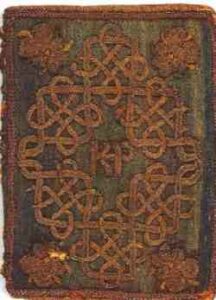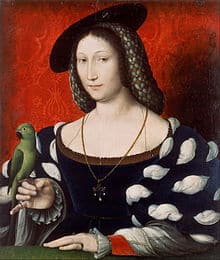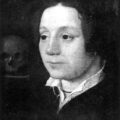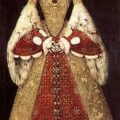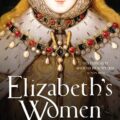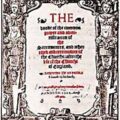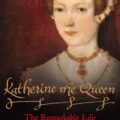Today, on Maundy Thursday (or Holy Thursday), the day we commemorate the Last Supper which Jesus Christ shared with his disciples, I thought it was fitting to look at “Le miroir de l’ame pecheresse” or “The Mirror (Glass) of the Sinful Soul”, the religious poem which Elizabeth translated as a gift for her stepmother Catherine Parr.
The Original Le Miroir
The original volume of devotional verse known as “Le miroir de l’ame pecheresse” was written by Queen Margaret of Navarre, also known as Marguerite of Angoulême, a woman known for her patronage of humanists and reformers and her radical religious views.
“Le Miroir” was first published in 1531 in Alencon and later made it to the English Court – it is thought that Anne Boleyn, Elizabeth’s mother, possessed a copy. Just 11 years after its first publication date, the 11 year old Elizabeth was translating it for Catherine Parr, a Protestant sympathiser. Elizabeth gave her translation, “The Glasse of the Synnefull Soule”, to Catherine as an New Year gift in 1545.
An article on Wikipedia describes “Le Miroir” as “a first-person, mystical narrative of the soul as a yearning female calling out to Christ as her father/brother/lover” but in her article, “Guilty sisters: Marguerite de Navarre, Elizabeth of England, and the Miroir de l’ame pecheresse”, Susan Snyder explains the content of this famous Renaissance and Reformist work in more details:-
“”The Mirror of the Sinful Soul,” is an outpouring (over 1400 lines) of self-accusation and self-abasement, recalling Paul and Augustine in its theological stance… The Reformist orientation is apparent in the poem’s Pauline-Augustinian bent, as in the prominence of biblical allusions. The speaker of the poetic monologue presents herself as a wretched sinner, who has so violated and betrayed her relationship with God that she is totally unworthy of his grace. Parsing out that relationship into a series of familial paradigms – daughter, mother, sister, wife – she explores each area of defection through an exemplary episode from the Bible. She becomes, in turn, the prodigal child who deserted her loving father; the mother with the dead baby who came for Solomon’s judgment; the sister of Moses who set herself up against his authority; and the adulterous wife of the prophet Hosea. There are other more incidental scriptural echoes marked in the margin, but the core episodes are chosen with special care. Each one displays not only sin and waywardness but an eventual return to grace. The prodigal is lost, and then found and rejoiced over (Luke 15); the bereaved woman before Solomon is shown to be the true mother of the living child, who is then restored to her (1 Kings 3); Moses’s sister Miriam, whom God struck with leprosy for challenging her brother’s supremacy, is cured through the intercession of that same brother and received back into the Israelite camp (Numbers 12); even the faithless harlot is reinstated as beloved wife in her husband’s home (Hosea 1-3).”
As you can see from Snyder’s explanation, “Le Miroir”, is a very personal account of one woman’s search for God and her personal and familiar relationship with God. It is also a poem whose focus is the sinful nature of the writer. So, how on earth, and why on earth, did an 11 year old girl choose such a literary work to translate for her stepmother? Possible reasons include:-
- Elizabeth found it amongst her dead mother’s possessions, wanted to translate it and thought her stepmother would enjoy its reformist slant.
- Catherine Parr suggested the poem to Elizabeth, who was a precocious and intelligent girl.
- Elizabeth chose the poem by herself, knowing that her stepmother would enjoy it.
Whatever the reason, the choice of poem shows Elizabeth’s maturity, intelligence and love for her stepmother.
 Two Sisters
Two Sisters
Snyder points out that Elizabeth had much in common with the author, Marguerite de Navarre, although Elizabeth was probably unaware of this. Both were the “elder sister of the favored royal male” – Marguerite to Francis I, King of France, and Elizabeth to Edward VI – and both were more intelligent than their brothers but this counted for nothing because they were women. Elizabeth’s situation was worse in that she was deemed illegitimate and was not the only sister, she had an elder half-sister, Mary.
Even though Elizabeth may have been aware of the parallels between her and Marguerite, Snyder writes of how, as Elizabeth worked on her translation, she must have thought how similar her own situation was:-
“Marguerite’s persona as errant sister and the paradigm of Miriam [the woman who rebelled against her brother Aaron’s authority] might well have found a responsive echo in her[Elizabeth]. Her own situation invited similar resentment: subordinate, apparently forever, to a brother who was her inferior in age and natural powers…But however fond Elizabeth was of Edward, her translation in its first printed form suggests the same complexity we have seen in Marguerite’s work, with female self-denigration sliding into female self-assertion.”
Elizabeth the Intellectual
David Starkey, in “Elizabeth: Apprenticeship”, writes of how Elizabeth’s gift to Catherine “advertised both her learning and (perhaps) her feminine accomplishments”. He quotes from Elizabeth’s summary of the theme of “Le Miroir” in her letter to Catherine:-
“how she (beholding and contemplating what she is [in the mirror or glass of the title]) doth perceive how of herself and of her own strength she can do nothing that good is or prevaileth for her own salvation, unless it be through the grace of God, whose mother, daughter, sister and wife by the Scriptures she proveth herself to be. Trusting also that, through His incomprehensible love, grace and mercy, she (being called from sin to repentance) doth faithfully hope to be saved.”
and comments that this summary is remarkable in that it is a quality precis of Marguerite’s complex work, in that “it manages to reduce the complexities of the doctrine of justification by faith to two clear, simple sentences”, yet Elizabeth is only 11 years old!To think that an 11 year old could handle translating such a poem and summarising a subject which, as Starkey says “leaves today’s undergraduates blank”! Elizabeth was obviously a very intelligent girl and one who relished a challenge.
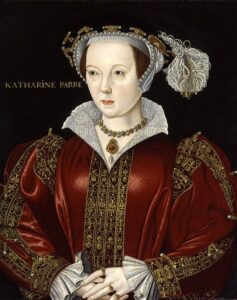
Le Miroir and Catherine Parr
Starkey writes that the question of gender in Elizabeth’s translation – “the loving, supplicating soul is female” and “the beneficent God” being male – is an echo of Catherine’s letter to her husband, Henry VIII, in July 1544, where Catherine had written about the doctrine of justification, explaining it “in terms of the love of the soul/Catherine for God/Henry”. Starkey wonders if “Le Miroir” was the inspiration for that letter and he even goes as far as suggesting that Catherine had been reading “Le Miroir” in the summer of 1544 and that she had not been reading it alone, she had been sharing it with her stepdaughter with the mission of converting her.
A Perfect Gift for Her Beloved Stepmother
Whether the poem meant anything to Elizabeth herself, we just don’t know, but the accompanying letter to Catherine shows us that Elizabeth thought that her stepmother would appreciate the gift. In the letter, Elizabeth writes:-
“Not only knowing the affectuous will and fervent zeal which your highness hath towards all godly learning…Which things considered have moved so small a portion as God hath lent me to prove what I could do. And therefore have I…translated this little book out of French rhyme into English prose, joining the sentences together as well as the capacity of my simple wit and small learning could extend themselves.”
We do not know whether Catherine and Elizabeth had spent time discussing “Le Miroir”, but Elizabeth knew her stepmother well enough to know that she would appreciate the themes of the book. It really must have warmed Catherine’s heart to have received such a gift, something that would have taken many hours of concentration to produce, something that was incredibly special. It is evidence of a wonderful, loving relationship between two intelligent women.
Sources
- Guilty sisters: Marguerite de Navarre, Elizabeth of England, and the Miroir de l’ame pecheresse by Susan Snyder
- “Katherine the Queen: The Remarkable Life of Katherine Parr” by Linda Porter
- “Elizabeth” by David Starkey
- “The Juvenile Translations of Elizabeth Tudor” by Roger Ellis
- Picture of Elizabeth’s “The Mirror of the Sinful Soul” book from www.marileecody.com
